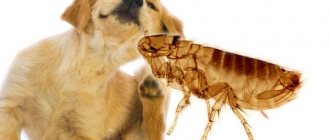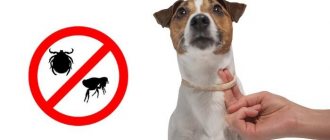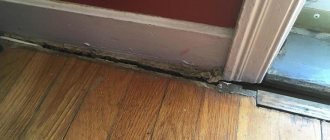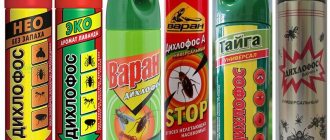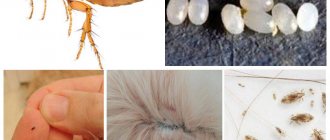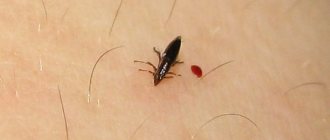Fleas can be safely described as the most annoying and widespread parasites, which consider dogs, other domestic animals, and, in the absence of such, humans as food sources. There is a widespread belief in everyday life that dogs living in outdoor conditions are especially susceptible to flea infestation.
In fact, all dogs are considered at risk, including those that live in an apartment and have virtually no contact with their brothers. When fleas appear, the animal is bothered by severe itching and pain; in addition, infection with parasites can cause the development of severe infectious diseases carried by these unpleasant insects.
If larvae and adult fleas are found on an animal's fur, for example, while bathing, you should immediately begin treating the animal. We will consider below which methods are particularly effective.
What to do if you find fleas
If you find even one flea on your dog, you need to act as follows.
Life cycle of fleas
- Do not delay treatment - fleas multiply at high speed. It will only take a few days for the pet to stop sleeping and eating, and for the insects to penetrate into all surrounding objects. It will be much more difficult to get them out of there than with a dog. In addition, in this case, there remains a high risk of re-invasion.
- Take a comprehensive approach to eliminating parasites. In addition to the pet, you will have to treat the room in which he lives (in the case of the street, this is an enclosure, a booth, everything that is in them). To ensure that you get rid of bloodsuckers, you will need to use not only folk, but also industrial pest control products.
- The drug for treating your four-legged friend must be selected in accordance with its characteristics, for example, age, attitude to washing, and state of health. Ideally, you should consult a veterinarian, but advice from people who have already encountered such a situation and successfully overcome it is also acceptable.
- During the period of disinfestation measures, the dog must be in “quarantine” - it is worth limiting it from free walking and communication with unfamiliar relatives.
Important conditions to resolve the problem
Important conditions for eliminating parasites include:
- Once fleas are discovered, action must be taken to eliminate them as soon as possible. If you hesitate, then after 1.5 weeks their number can increase up to 10 times.
- When choosing a product, it is recommended to consult a veterinarian, who will select the best option for the animal depending on its condition and age.
- It is very important to follow the instructions for the drug exactly - this will avoid poisoning and other health problems.
It is important to use an integrated approach to flea removal: you need to not only treat the pet itself, but also the room. It is recommended to combine industrial insecticides and traditional methods.
Industrial means for removing fleas
At the moment, there is a huge range of products that can be used to remove fleas from a dog. However, for all their effectiveness, each of them has only a temporary effect, because these parasites are widespread everywhere. As soon as the treatment ends, the flea may appear again. Therefore, you need to know what you can do to prevent an invasion, how to quickly get rid of insects, and how to maintain the result in the future.
Shampoos
Washing the dog
Shampoos help remove fleas from dogs only if there are a minimum number of them; as the insects multiply, this type of treatment completely loses its effectiveness. Products containing insecticides, such as permethrin, help get rid of parasites. However, this component can cause an allergic reaction, the signs of which are: excessive salivation and vomiting.
There are also products for disinfestation of dogs with natural ingredients. Plant extracts have an antipruritic, anti-inflammatory, healing effect, and keep your pet's hair in a healthy condition. After applying flea shampoo to the dog, carefully distribute it over the body (avoiding contact with the eyes, nose and mouth), leave for a while (according to the instructions), and rinse. After drying, it is recommended to comb the dog with a fine-toothed comb.
Among the most popular shampoos for fleas on dogs are: Mr. Bruno, Bars, Phytoelite.
Flea shampoo Mr. Bruno
Shampoo Bars for fleas
Shampoo Phytoelite for fleas
Drops
Applying flea drops
You can quickly get rid of blood-sucking parasites from your four-legged friend at home using drops. This option is more effective than the previous one, and therefore enjoys deserved popularity. The effect of the contents of the bottle lasts for about a month (provided that the instructions are followed).
The drops are applied to the dog’s skin in a place that is inaccessible to licking (most often the scruff of the neck). The active ingredient is toxic to bloodsuckers; it penetrates the animal's epidermis and bloodstream, resulting in the elimination of insects. However, before removing fleas from a dog with drops, you need to consult a veterinarian, since the active ingredients have side effects and contraindications.
Among the drops we can note: Bars Forte, Celandine, Barrier, Frontline.
Bars Forte
Celandine
Collar
Using a collar to remove fleas from a dog, although convenient, presents certain difficulties.
This method is not suitable for puppy-aged pets, expecting dogs or nursing dogs, since the insecticides with which the collar is impregnated can have a negative effect on the puppies' body. Collars containing natural substances, as well as ultrasonic ones, are safer. At the same time, the latter option is too expensive, and natural ingredients are not effective against heavy flea infestations. Another drawback of flea collars is that poisonous compounds are distributed unevenly throughout the body. In addition, the product is not recommended to be used simultaneously with other methods.
Sprays
Flea spray for dogs
You can remove fleas from your dog using a spray. This form of processing has gained popularity due to its ease. It is enough to apply the product to the fur in the pet’s neck area, after which the parasites will remain on the animal for at least 3-4 weeks.
The disadvantage of using a spray to combat fleas is the high content of toxic substances in the composition. The contraindications are the same as for the collar. There is also a possibility of licking off the drug if it gets on other parts of the body.
Frontline is considered the most effective tool in this group; Bars and Beafar aerosols are no less popular among dog breeders.
Powder
An insecticidal remedy for fleas on dogs in powder form has not found significant distribution among dog breeders. This is due to the need to rub the product with your hands into the skin and hair of the animal. In addition, the use of this processing method increases the risk of poisoning. Powders are not used when it comes to puppies, pregnant dogs, lactating dogs and weakened ones.
Among the powdered preparations we can highlight: Sanal, Insectal.
Pills
The tablet form of flea control also did not catch on among dog owners. Chewable tablets slightly reduce the number of parasites, but do not remove them completely. In addition, this method of disinsection is dangerous due to poisoning and allergies. Treatment consists of adding the drug to the animal’s feed.
Veterinary pharmacies offer drugs such as Comforts, Capstar.
Causes of flea infestation
It is impossible to completely and forever protect a dog from parasites, because there are incredibly many possibilities for infection with them. Whether on the street or in the apartment, there are no safe places. Fleas can be found anywhere, even in the most unexpected places. But we can identify the main reasons for the appearance of “vampires” in animals:
- Any walks in nature or even around the city;
- Contact with other animals;
- Larvae.
In the first case, it is obvious that hungry insects are patiently waiting for victims. They have no preference in choosing where to ambush. Grass, foliage, and soil will do. They can be found on the playground, on sidewalks and on public transport. They are everywhere. And there is a simple explanation for this: an animal overpopulated with fleas throws off some of the parasites.
But the risk of having uncomfortable “guests” is even higher - communication between pets. A dog easily picks up fleas, even if it is half a meter away from an infected animal. There is also a risk when interacting with a completely domestic animal.
Larvae, like fleas themselves, can be everywhere. But they are the easiest to bring into a person’s house. On shoes or clothes along with dirt and stuck leaves.
Fleas are tenacious creatures. It is not difficult for them to move freely from one place to another in search of food. They can get into the house through open windows and doors, and even in women's handbags or grocery bags.
IMPORTANT: Fleas are often confused with lice. They are easy to distinguish: the body of lice is usually large and flat, and the legs are short. Fleas are brown in color and lice are grayish-white. The latter are less common, mainly in unkempt pets and stray dogs.
Flea classification
It is difficult for a non-specialist to distinguish one type of flea from another, because to the eye they look the same. But the flea classifier includes many families and species of these insects.
Most often, it is generally accepted to separate fleas according to their choice of prey: human, cat, rat, etc. There is also Ctenocephalidis Canis - this is the so-called dog flea. In fact, not only this species, but also many other species parasitize the dog.
The human flea feeds on the blood of both humans and their domestic animals. They are saturated with blood in 20 minutes, and then digest it for another six hours.
IMPORTANT: Subcutaneous fleas are a myth. There are many parasites that live under the skin, but fleas are not one of them. Duck mites are also mistakenly mistaken for fleas.
- The cat flea also parasitizes other animals and humans.
- A dog flea is similar to a cat flea, but lives a little less (six months to one and a half years). These insects are sources of flatworms and plague.
- More dangerous than the previous ones is the rat flea. She is a carrier of rat and mouse tapeworm.
- The black flea, unlike, for example, the dog flea, reproduces very quickly: the time from being in the larval stage to becoming an adult is barely four days.
- There are grass fleas that are mistaken for other species of fleas. Unlike the others, the grass one has wings, albeit barely noticeable. It is active from mid-spring to mid-summer, but there are exceptions. If you don't get rid of it in time, it can bother you all year round.
IMPORTANT: Grass fleas often inhabit vegetable gardens and eat plants. But this does not mean that they are harmless to humans and animals.
Another special species is the bed flea. Already from the name it is clear where it lives.
Read Etiology of actinomycosis in dogs: signs, therapy and prevention
How fleas reproduce on dogs
The peculiarity of their reproduction is that in cold weather they prefer not to mate. The ideal temperature for this is 18-25 degrees. Mating itself takes several hours, so it does not happen on the dog’s body, but somewhere in a secluded corner.
The life cycle of these bloodsuckers includes four stages:
- Egg. The female lays them little by little: only 4-8 eggs at a time. Eggs rarely remain on the pet itself; they usually fall to the floor due to their non-stickiness.
- Larva. The dog flea hatches after 8-14 days and begins to feed on the excrement of adults. She needs excrement because it contains undigested blood. Their diet also includes other waste, including rotted grass.
- Doll. After two molts, the pupa weaves a cocoon, which subsequently sticks to it. The flea remains in this stage until a victim appears nearby.
- Imago. Adult stage. Their lifespan greatly depends on the conditions in which they live. At low temperatures they live longer.
Folk remedies for fleas on dogs
An alternative to industrial drugs is to remove fleas from dogs using folk remedies. They are generally effective if insects are present in small numbers. However, as a preventive and auxiliary remedy, folk methods are irreplaceable.
Flea head under a microscope
- Herbs. The most popular and effective plants that can repel fleas are: wormwood, tansy, eucalyptus, hellebore. The last option is sold in pharmacies and is the most powerful remedy; its use requires caution, since exceeding the recommended dose threatens severe intoxication of the animal’s body. Decoctions or infusions are prepared from the plants and used to bathe the dog. Using herbs is an excellent and safe way to get rid of fleas in puppies.
- Laundry soap. To rid your pet of blood-sucking insects, you need to make a solution from laundry soap. To do this, eucalyptus leaves are boiled in a separate container in advance. After cooling, add a little cedar (fir, pine, tea tree) oil and grated soap. The resulting liquid is used to wash the dog. It can be stored at room temperature.
- Garlic. Fleas cannot stand the smell of garlic, but during treatment you need to carefully monitor your pet - for dogs, this plant poses a danger (even death) if ingested. To prepare a medicinal solution, grind 2-3 cloves, add 200 ml of water, and leave overnight. The resulting liquid can be applied only to those areas of the body that the animal cannot lick.
- Onion. It works the same way as garlic. To treat a pet, finely chop the head, fill it with water, and add soap (preferably tar or laundry soap). After stirring, treat the animal’s fur with the solution.
- Apple vinegar. To get rid of bloodsuckers, generously moisten the dog’s body with an aqueous solution of apple cider vinegar and leave for 60 minutes, then rinse off and comb the hair well. To prepare, you will need one part vinegar and three parts water.
- Essential oils. Fleas are afraid of any strong odors, especially citrus, eucalyptus, pine, and tea tree esters. Oils are recommended for direct application to the dog's coat or adding to bathing water.
Symptoms and external signs
The main symptom is the dog’s anxiety: it tends to change its position while resting, twitch, and jump up. A flea-covered dog stops loving bathing. Any entry into the water evokes an irresistible desire to get out onto land.
An obvious sign is that the animal has bitten itself, scratched itself furiously, and its eyes are filled with irritation or anger.
Other signs are visible when scratching: red spots on the skin (this is not an indicator if the dog has allergies), eggs and excrement on the fur. Wounds and areas with ulcers also indicate possible infection.
Fleas bite in their favorite places - the withers, ears and stomach. That's where you should look for them first.
How to remove fleas from puppies
It is more difficult to remove fleas from dogs of puppy age than from adults, since most of the products on the market are indicated for six months. Only a few drugs are approved for use:
- from 1.5 months - Bars and Stronghold in spray form, Celandine and Phytoelite shampoos;
- from 2 months – Celandine and Frontline in the form of drops, Beafar collar.
Before using these medications, you need to study the instructions to find out how to properly kill fleas and prevent poisoning of the puppy.
Note: the best option for puppies would be to use folk methods and remedies: tar soap, wormwood.
Danger to dogs
For animals whose body is covered with abundant fur, a flea bite is potentially dangerous. These small and seemingly harmless jumping insects inject their saliva into the wound of the bitten person.
Such an “injection” can lead to a number of pathologies:
- excessive hair loss;
- severe itching and redness of the skin in the bite area;
- infection with worms (occurs if a cat or dog accidentally eats a flea);
- transmission of viruses;
- bacteria entering the wound that provoke an allergic reaction;
- in especially severe cases, anemia is observed, which threatens the life of the animal.
A dog attacked by fleas begins to itch intensely, which causes the pet many unpleasant moments. Scratched areas of the skin often become inflamed and cause skin diseases.
Moving from an infected animal to a healthy one, fleas quickly multiply and begin to drink the blood of a new owner. Insect activity increases sharply in spring or autumn.
On a note . Fleas practically do not parasitize humans and are not transmitted to them from pets. As a rule, humans are too hairless for these insects, so the parasites are not found on the human body. However, the risk of flea infestation still exists.
Is there a flea vaccination?
Flea spray for dogs
Many owners would like to have their pet vaccinated against fleas. As such, there is no flea vaccine. However, grafting is often referred to as insecticide injection. The injection acts like drops, but the effect can last up to six months. The mechanism of action of the vaccination is as follows: when bitten by an insect, it receives a dose of a toxic substance that causes a disturbance in the parasite’s nervous system, and then its death.
The positive aspects of flea injections for dogs include the simplicity of the method. To protect your pet from bloodsuckers, only a single injection is required. In addition, the possibility of the drug entering the animal’s gastrointestinal tract is completely eliminated, which means there is no risk of poisoning. An additional advantage is that the product is available in different versions, providing for the treatment of dogs of different ages and colors.
Not all dogs can receive flea injections. Injections are contraindicated for puppies under 2 months of age, weak pets, and people with allergies. You cannot vaccinate yourself - this must be done by a veterinarian after a preliminary examination of the dog. The most commonly used anti-flea vaccinations are: Lufenuron, Eprimek, Ivermectin.
Chemical pest control agents
If traditional methods do not help or the dog has developed an allergy, you can purchase special industrial preparations aimed at fighting fleas.
Shampoos
Shampoos have a short-term effect, so they are recommended to be used as a preventive method. There are shampoos based on natural ingredients and insecticides. The latter should be used carefully - they can cause allergies. The most famous brands: Beaphar, Fitoelita, Celandine.
Drops
It is considered the most popular and easiest to use product. The number of drops depends on the weight of the dog. On average, the drug lasts 3–5 weeks, then you need to apply the drops again to the withers. The most popular drops: Frontline spot, Celandine.
Sprays and aerosols
Such formulations are very effective, but there may be problems with their use. When using them, you need to try not to point the stream at the face, then make sure that the dog does not lick itself for at least 6 hours. Popular means: Stronghold, Frontline, Bars.
Anti-flea collars
The main advantage is that the effect of the collar can last up to 9 months. It is recommended to put it on your pet at the very beginning of spring. However, if fleas appear, it will not be possible to cure the animal with just a collar. It should not be used on puppies or pregnant dogs. Popular options: HartZ, Beaphar.
Powder
Considered the cheapest option. Powders are manufactured in veterinary pharmacies to order, taking into account the weight of the dog. The main disadvantage is the inconvenience and duration of use.
Pills
Tablets are a fairly common method for controlling fleas. However, it should be noted that this method is not effective enough - it is necessary to combine it with other drugs. In addition, the disadvantages of tablets include the fact that in some cases they can cause allergies. The most popular tablets are Comforts, Capstar.
Treating the area where the dog lives
To remove fleas from a dog, it is not enough to treat only the pet. The insects living next to it will return to the “host” as soon as the drug expires. Therefore, it is necessary to simultaneously carry out a thorough disinfestation of the premises (apartment, house, booth) in which the pet lives.
Treating your apartment for dog fleas
There are several ways to disinfect an apartment. You can use one, the most suitable one, or you can use several at once.
What do fleas look like on a dog?
- Thermal impact. If the temperature outside is sub-zero, it is enough to take the things in which fleas have settled outside for a few hours outside. Insects can also be killed by exposing them to boiling water (by dousing or boiling them).
- Chemical attack. Products such as Karbofos, Reid, Fenaxin and the like are used to treat floors, walls, corners, utility rooms, and large interior items (for example, upholstered furniture). You can use insecticidal preparations in the form of a spray or powder that were used to treat the dog. It is important that there is not a single untreated corner left, otherwise the processing will have to start all over again.
- Traditional methods. Among the folk methods for treating an apartment from dog fleas, the same means are used as for disinsection of a pet. These are: wormwood, kerosene, pine sawdust and others. Only kerosene treatment leads to the death of insects; other methods can be used as a complement to the chemical option. Infusions and decoctions are prepared from the plants, which are used to wipe all surfaces in the house, preferably several times a day. As an option, spread fresh wormwood around the apartment (along the baseboard, in corners, under furniture), and change it as it dries for a month (minimum).
- The professional way. The services of special services for exterminating fleas indoors are sought in difficult situations, when other methods are ineffective. The essence of professional treatment is the artificial creation of fine vapor particles containing an insecticide. These particles settle on surfaces, penetrating deep into porous materials, causing the death of insects.
Processing the dog house
When removing fleas from a dog, you also need to put things in order in the kennel. To destroy insects, the same methods and preparations are used as in the apartment. The litter must be burned, and to prevent the return of bloodsuckers, branches of wormwood or tansy should be laid out inside and around the booth (they should be periodically replaced with fresh ones).
Signs of a pest
In order to quickly and effectively remove parasites, you need to find out in a timely manner that your dog has fleas. There are several main signs that may indicate that an animal is infected.
The main ones are the following:
- The dog is bothered by constant itching and pain, and the animal’s behavior changes accordingly.
- When a huge number of parasites appear on the animal’s fur, the dog’s condition rapidly deteriorates. There is a lack of appetite, weakness, and lethargy.
- On the animal’s fur you can see white, dark dots, which represent eggs, larvae, and adult parasites.
It is also recommended to know what a dog flea looks like. This is a small insect, no more than three millimeters long, with a dense shell, powerful hocks, and six pairs of legs. The color of the parasite can vary from yellowish to distinct brown.
Safety rules for processing
Since killing fleas on dogs and indoors involves the use of highly toxic chemicals, precautions must be taken.
- Do not use drugs and products that have expired;
- carefully read the instructions for using a particular product, especially when it comes to treating puppies, weakened and pregnant animals;
- if it is not possible to contact a specialist, when choosing a drug, pay attention to the dosages indicated in the instructions, the characteristics of the animal’s age, and recommendations for further observation;
- if your pet becomes ill during the procedure, you need to urgently take him to the clinic or call a specialist at home;
- Before you start disinfesting the premises with chemicals, you need to remove all household members, including pets;
- Processing should be carried out using rubber gloves and a respirator (or medical mask);
- After the disinfestation is completed, you must leave the apartment, wash your face and wash your hands.
You can return to the treated room after the period specified in the instructions for the product used.
Traditional methods
They were mentioned a little earlier, as they are applicable for newborn babies. Traditional methods are based on the use of herbs. That is why they are so harmless for newly born puppies.
If the mother and offspring are in an enclosure or in a room separate from human habitation, then it would be good to place bunches of herbs such as wormwood, lavender, and bugs around the bed. They have a pungent odor that will repel nasty insects. For the convenience of animals, the bunches can be replaced with powder from the same plants. Herbs are safe even for babies, who may accidentally get the herb inside.
If animals live in the house, then the litter and the surrounding area should be treated with water with the addition of a couple of drops of essential oil of the same lavender, lemon, menthol or eucalyptus. This method also has a deodorizing and antimicrobial effect.
Do not forget about baths using herbs that have a pungent and repellent odor.
Flea prevention
It is almost impossible to prevent fleas from appearing on your dog, but you can significantly reduce the likelihood of parasite infection. To do this, you need to follow a number of recommendations:
- when going for a walk, wear a flea collar;
- use medications approved for prophylaxis (for example, injections);
- regularly treat the place where the pet lives, its bedding, with appropriate pest control agents;
- avoid contact between your pet and unfamiliar relatives;
- keep the dog clean, monitor the condition of the coat;
- do not walk in places known to be inhabited by fleas (basements, abandoned areas).
What means to remove fleas from a dog is up to each owner to decide according to his or her capabilities. The main thing is to notice the problem in a timely manner and prevent the proliferation of insects.
Answers to popular questions
Probably, almost every dog owner, when parasites appear in an animal, is interested in the following questions: how quickly fleas reproduce, what types of fleas can be found in dogs. As mentioned above, insects are not particularly picky in their diet; therefore, a dog can be attacked directly by dog fleas, rat fleas, human fleas, and many others. However, regardless of the species of insects, it is recommended to use similar preparations to remove them.
How does a pet become infected?
To somewhat protect your pet from parasite infection, it is important to know where fleas come from in dogs. More often, infection occurs through close contact between animals, for example, during play or fighting. However, there are many other ways. So, danger can lie in wait for a dog on the grass, earth, sand. Insects, falling from an infected animal into the external environment, can remain viable for a very long time.
Even if the animal practically does not go out for street walks (more often, keeping it exclusively in an apartment is necessary for puppies that do not have all the necessary vaccinations, as well as small breed dogs), there is a risk of infection.
This can happen upon contact with the owner's street shoes or the wheels of a baby stroller. That is, there are an incredible variety of ways to infect a dog with fleas.
Are fleas dangerous for humans?
Dog fleas may well pose some danger to humans. These parasites are not selective in their nutrition, that is, in the absence of an animal, they may well be considered a source of human nutrition.
Since fleas are carriers of serious diseases of infectious etiology, a parasite bite can cause the development of such dangerous ailments as typhoid, salmonellosis, and various types of helminthiasis. In order to avoid infection, you should begin removing parasites from an animal immediately after detecting signs of infection.
Preventive actions
How to protect your home, pet and yourself from bloodsuckers? To reduce the risk of infection with blood-sucking parasites, dog owners should:
- keep your home clean;
- Regularly clean, disinfect and replace your dog’s bed;
- wash the booth and enclosure;
- floors, upholstered furniture, floor coverings must be vacuumed at least 2-3 times a week;
- examine dogs after a walk, mating, visiting a veterinarian, or participating in an exhibition;
- try to protect your pet from contact with other animals during a walk;
- walk dogs in strictly designated areas;
- use flea collars;
- At least twice a year, carry out preventive treatment of the dog with flea drops.
